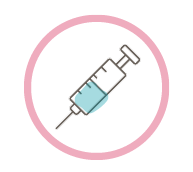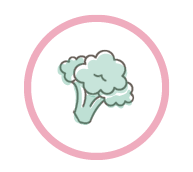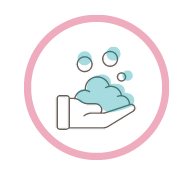When you’re living with COPD (Chronic Obstructive Pulmonary Disease), protecting your lungs from infection is the first step to achieving a better quality of life. But because there are many types of COPD1, finding ways to manage your individual symptoms can be challenging.
Living with COPD
Symptoms of COPD include shortness of breath, wheezing, and tightness in the chest2. For many patients, your clinician may recommend making certain lifestyle changes to reduce your exposure to bacteria and other pollutants in the air. According to the American Lung Association, COPD patients can still enjoy a rich, active lifestyle by incorporating healthy habits into their everyday routine.
5 Wellness Tips for Patients Living with COPD
 1. Avoid Smoking: If tobacco use has caused your COPD symptoms, you’ll need to quit smoking. This includes avoiding exposure to secondhand smoke, as well3.
1. Avoid Smoking: If tobacco use has caused your COPD symptoms, you’ll need to quit smoking. This includes avoiding exposure to secondhand smoke, as well3.
 2. Schedule Annual Vaccinations: Proactively trying to prevent cold and flu symptoms is another effective way to protect your lungs from infections. The American Lung Association recommends that you avoid crowds during flu season and remember to get your annual flu shot4.
2. Schedule Annual Vaccinations: Proactively trying to prevent cold and flu symptoms is another effective way to protect your lungs from infections. The American Lung Association recommends that you avoid crowds during flu season and remember to get your annual flu shot4.

3. Reassess Your Diet: The types of nutrients we consume every day may affect how oxygen gets distributed to our lungs. “For some people with COPD, eating a diet with fewer carbohydrates and more fat helps them breathe easier.”5 It’s best to consult with your clinician on the types of foods to incorporate (or avoid) in your diet.

4. Exercise Regularly: COPD is often characterized by shortness of breath. Incorporating moderate exercise into your routine can help improve your body’s flow of oxygen, thereby improving your ability to breathe better6. Visit the American Lung Association for examples of exercises designed for people with COPD.

5. Keep Up the Hygiene Routine: When you have COPD, your lungs begin to weaken, making them more prone to infection. “The lungs are different from most of the other organs in your body because their delicate tissues are directly connected to the outside environment.”7 Washing your hands frequently can help prevent bacteria causing respiratory infections.
In addition to managing COPD with healthier habits, you’ll also need to find an effective treatment approach that helps monitor and reduce symptoms from worsening. The earlier you can incorporate COPD treatment into your routine, the greater chance you have of not letting chronic symptoms get in the way of your time spent with loved ones and doing the activities you enjoy.
In a 2018 press release from the American Lung Institute, a study conducted by the National Institute of Health estimated that approximately 11 million people may be unknowingly living with COPD8. If this trend continues, more undiagnosed patients will miss out on early COPD treatment, thereby increasing the disease’s prevalence, and heightening the risk of comorbid conditions.
What is Comorbidity?
In terms of COPD, comorbidity occurs when patients experience two chronic lung conditions simultaneously9. In the Electromed video series, “Ask a Pulmonologist,” Dr. Frederic Seifer discusses patients living with COPD and bronchiectasis. He affirms that because bronchiectasis often mirrors COPD symptoms, it becomes more difficult for clinicians to differentiate between the two conditions, leaving them to diagnose one over the other. Though the causes of bronchiectasis and COPD are different, treating both conditions may be more similar than you think.
The Relationship Between COPD & Bronchiectasis
In a previous blog post, we discussed the differences between bronchiectasis and COPD, including a breakdown of symptoms as well as how the conditions typically develop.
Symptoms may make it difficult for your lungs to clear mucus effectively, which is why airway clearance is an effective method for treating chronic pulmonary conditions, like COPD and bronchiectasis. With nowhere to go, mucus builds up in the lung. This attracts bacteria that leads to infection. With each infection, lungs become more damaged. To help treat an impaired breathing condition, like COPD and bronchiectasis, airway clearance is key.
Airway clearance, when delivered through high frequency chest wall oscillation (HFCWO), helps loosen, thin, and propel mucus through the airways where it can be more easily coughed out. By regularly performing HFCWO therapy, typically once in the morning and once at night, patients can manage their symptoms and reduce the cycle of mucus buildup and recurring infections.
For more tips on living with COPD, visit our blog page or explore our resources to find active support communities. To learn about the SmartVest Airway Clearance System, and how our HFCWO therapy vest works to help you relieve symptoms and enjoy a healthy lifestyle, contact us today!
-
COPD Foundation. “What Is COPD?” Retrieved from https://www.copdfoundation.org/What-is-COPD/Understanding-COPD/What-is-COPD.aspx
-
COPD Foundation. “What Is COPD?” Retrieved from https://www.copdfoundation.org/What-is-COPD/Understanding-COPD/What-is-COPD.aspx
-
American Lung Association. “Protecting Your Lungs.” Retrieved from https://www.lung.org/lung-health-and-diseases/lung-disease-lookup/copd/living-with-copd/protecting-your-lungs.html
-
American Lung Association. “Protecting Your Lungs.” Retrieved from https://www.lung.org/lung-health-and-diseases/lung-disease-lookup/copd/living-with-copd/protecting-your-lungs.html
-
American Lung Association. “Nutrition and COPD.” Retrieved from https://www.lung.org/lung-health-and-diseases/lung-disease-lookup/copd/living-with-copd/nutrition.html
-
American Lung Association. “Physical Activity and COPD.” Retrieved from https://www.lung.org/lung-health-and-diseases/lung-disease-lookup/copd/living-with-copd/physical-activity.html
-
American Lung Association. “Protecting Your Lungs.” Retrieved from https://www.lung.org/lung-health-and-diseases/lung-disease-lookup/copd/living-with-copd/protecting-your-lungs.html
-
American Lung Institute. “Thousands of Minnesotans Could Be Unknowingly Living with COPD.” Retreived from https://www.lung.org/local-content/_content-items/about-us/media/press-releases/thousands-of-minnesotans.html
-
COPD Foundation. “What Is COPD?” Retrieved from https://www.copdfoundation.org/What-is-COPD/Understanding-COPD/What-is-COPD.aspx


